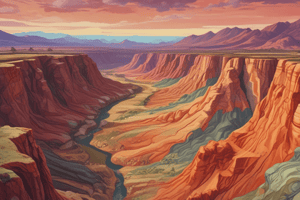Podcast
Questions and Answers
What is the characteristic of massive igneous rocks?
What is the characteristic of massive igneous rocks?
- They are always found on the surface
- They have a uniform color and structure (correct)
- They have layers and varying colors
- They are typically small in size
What type of igneous intrusion forms like a wall?
What type of igneous intrusion forms like a wall?
- Sill
- Dyke (correct)
- Laccolith
- Batholith
What is the process of mechanical weathering that occurs when the outer layers of igneous rock are peeled off?
What is the process of mechanical weathering that occurs when the outer layers of igneous rock are peeled off?
- Weathering
- Erosion
- Exfoliation (correct)
- Denudation
What is the largest and deepest of all intrusive igneous features?
What is the largest and deepest of all intrusive igneous features?
What type of igneous intrusion forms like a saucer under the ground?
What type of igneous intrusion forms like a saucer under the ground?
What is the result of a dyke being exposed to the surface of the Earth due to erosion of softer rock around it?
What is the result of a dyke being exposed to the surface of the Earth due to erosion of softer rock around it?
What happens when granite is close to the surface and comes into contact with groundwater?
What happens when granite is close to the surface and comes into contact with groundwater?
What is the orientation of a sill?
What is the orientation of a sill?
What is the primary cause of exfoliation?
What is the primary cause of exfoliation?
What type of igneous rock is often formed from granite?
What type of igneous rock is often formed from granite?
Flashcards are hidden until you start studying




